Summary
In this article, we consider capillary-gravity waves propagating on the interface of two dielectric fluids under the influence of normal electric fields. The density of the upper fluid is assumed to be much smaller than the lower one. Linear and weakly nonlinear theories are studied. The connection to the results in other limit configurations is discussed. Fully nonlinear computations for travelling wave solutions are achieved via a boundary integral equation method. Periodic waves, solitary waves and generalised solitary waves are presented. The bifurcation of generalised solitary waves is discussed in detail.
1. Introduction
Electrohydrodynamics (EHD) is concerned with the interaction of charged fluid motion with electric fields. When performing experiments, it is much easier to artificially manipulate the electric field than it is to vary surface tension. EHD has numerous industrial chemical engineering applications, such as electrospray technology (1–3), enhanced heat transfer (4), cooling systems which make use of conducting fluids in high-power devices (5), coating processes (6, 7) and so on. Two comprehensive reviews of advances and applications in EHD can be found in (8, 9). EHD problems often concern an interface between two fluids, and hence an enhancement in the understanding of fluid dynamics benefits the engineering community. Research on EHD interfacial waves was first conducted by (10), who showed theoretically and experimentally that the interface between a dielectric and a conducting fluid can be destabilised by normal electric fields. It was followed by (11), who performed a linear stability analysis of interfacial flows under electric fields that are parallel to the undisturbed surface, and found that short waves can be regularised under such circumstances. Being inspired by these two earlier works, many authors considered the role of EHD in both stabilising and destabilising interfacial fluid configurations. Kelvin–Helmholtz and Rayleigh–Taylor instability were considered by (12) and (13, 14) respectively, where horizontal electric fields were shown to be capable of suppressing these instabilities. The results were achieved by using reduced model equations in (12, 13) and by direct numerical simulations in (14). Travelling waves of finite amplitude on capillary sheets under the influence of tangential electric fields were computed in (15) by a boundary integral equation method.
The problem of capillary-gravity travelling waves propagating under vertical electric fields in two-dimensions has been investigated by many authors for different configurations as summarised by (9). The general set up consists of two immiscible dielectric fluids with different electric permittivities, with an interface in between. To reduce the complexity of the problem, some assumptions were made in previous works. For example, (16, 17) assumed that the upper layer is much larger than the lower one. Under the long wave limits, Boussinesq-type models were derived and computed in the former literature whereas a boundary integral equation method was used to compute fully nonlinear solutions in the latter one. Another common assumption is to consider the case when one of the layers is a perfect conductor. Korteweg de-Vries (KdV), modified KdV, forced KdV and KdV-Benjamin–Ono equations were derived for long waves respectively by (18–20, 22) in the case of a layer of conducting fluid on the bottom and a dielectric on the top. The works were extended to three dimensions by (23, 24). On the other hand, in the case where the upper region is a conducting gas, (25, 26) computed fully nonlinear travelling solitary waves on a dielectric fluid of infinite and finite depth respectively as well as their dynamics based on a time-dependent hodograph transformation technique. To our knowledge, no fully nonlinear computations have been performed so far for the general set up of two dielectrics with two finite depth layers. This is the main focus of this work.
The rest of the article is structured as follows. Detailed formulations are given in section 2, and followed by a linear theory in section 3 and a weakly nonlinear theory in section 4. The numerical scheme and the results are presented respectively in section 5 and 6. A conclusion is given in section 7.
2. Formulation
We consider the two-dimensional irrotational flow of an inviscid incompressible fluid of finite depth that is bounded below by an electrode and above by a hydrodynamically passive gas, which in turn is bounded above by another electrode (see Fig. 1). The fluid and the passive gas are assumed to be perfect dielectrics with permittivity and respectively. The problem can be formulated by using Cartesian coordinates with the -axis directed vertically upwards and at the mean level of the interface between the fluid and the gas. We take as the undisturbed depth of the fluid, and as the undisturbed depth of the passive gas. The effects of gravity and the surface tension are both included in the formulation. The interface between the fluid and the gas is a free surface whose unknown equation is denoted by . A wavetrain is assumed to travel rightwards following the direction of the -axis. We denote the voltage potential in the fluid and the gas by and respectively. Without loss of generality, we choose on the bottom electrode. Continuity of the tangential component of the electric fields results in the condition that and are equal on the free-surface, up to an arbitrary constant, which without loss of generality we take to be zero. The potential on the upper electrode is then a fixed parameter of the problem, which we denote by . This choice of on the upper electrode is chosen such that, in the case where , the electric field approaches a uniform vertical electric field with strength .
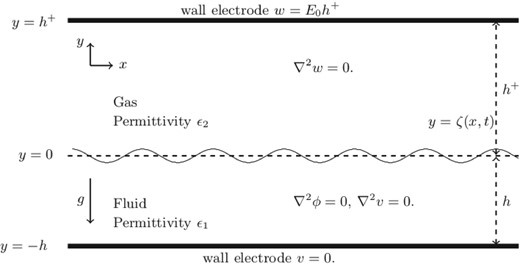
Fig. 1
Configuration of the problem. The gravity acts in the negative -direction. We denote the equation of the unknown free surface by .
Since the fluid motion can be described by a velocity potential function
,the governing equations can then be written as
and
where the subscripts denote partial derivatives,
is the Bernoulli constant and
is the Maxwell stress given by
with
being the ratio of the permittivity from two layers. The last three terms of (
2.10) are the forces due to gravity, surface tension, and the Maxwell stresses due to the electric field. Equations (
2.4) and (
2.5) are the kinematic boundary conditions on the interface and bottom electrode respectively. The conditions (
2.6) and (
2.7) fix the electric potentials at the electrodes. Finally, continuity of the tangential components of the electric field and continuity of the normal component of the displacement field are given by (
2.8) and (
2.9) respectively. By making use of (
2.8), (
2.9), the Maxwell stress (
2.11) can be simplified as
3. Linear theory
By choosing
,
and
as the reference length, time and the strength of electric field, the bottom is at the level
, and the system is still governed by the Laplace equations but with the dynamic boundary condition (
2.10) becoming
and
where
is the inverse Bond number and
is the inverse electric Bond number defined by
The boundary conditions on the voltage potential are now scaled to be
where
. The kinematic conditions (
2.4), (
2.5), (
2.8) and (
2.9) remain unchanged. The trivial solution
,
gives rise to the following electric potentials
where
. We linearise the system about the trivial solution by writing
where
,
is the angular frequency,
is the wavenumber,
represents the real part, and
,
and
are constants to be found. For right-travelling waves, the wavenumber
is always positive. The forms of these solutions ensure that (
2.1), (
2.2), (
2.3), (
2.5), (
3.5) and (
3.4) are satisfied. Substituting into (
2.4) and (
2.10) yields the following dispersion relation
Here, is the wave phase speed. It can be seen from equation (3.8) that if for some , then the configuration is linearly unstable to perturbations with wavenumber . Noting that the term following is positive for all , we can see that the vertical electric field is destabilising when the top electrode is held to a higher electric potential than the bottom one, while the effects of surface tension are stabilising. There are a variety of limiting configurations we will consider below.
The dispersion relation (3.12) for a variety of parameters is shown in Fig. 2.
In the case where the upper electrode is placed infinitely far away from the fluid (
), we find that
This configuration was seen in (16, 17), where the electric field at is given by .
In the particular case where the gas is a perfect conductor, as explored by (26), the governing equation (2.3) in the upper region is replaced by . This gives for . For any value of that is not unity, we rescale the voltage potentials such that on the bottom electrode, and on the upper electrode.
Hence, the boundary conditions (
2.8) and (
2.9) for the electric fields on the interface are replaced by
. The dispersion relation can be recovered from equation (
3.12) by taking
(and hence
), giving
In the case where the fluid is taken to be a conductor and the gas a dielectric, equation (
2.2) is replaced by
, and the boundary conditions (
2.8) and (
2.9) give
on
. Such a configuration was considered by (
21, 24). For this case,
is no longer a valid non-dimensional constant (since
). We instead define
The Bernoulli equation in this instance becomes
Using the expansions (
3.8), (
3.9) and (
3.11) with
to satisfy
on the free surface, we find the linear dispersion relation
The similarity between equations (
3.14) and (
3.17) when
is discussed in (
26). On the other hand, when
, (
3.17) reduces to
This set up was investigated in (22, 23).
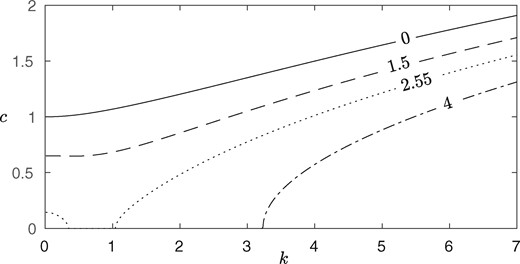
Fig. 2
Dispersion relation (3.12) with parameter values , , . The values of are shown in the figure.
Below, we consider the general case of dielectric-dielectric, as given by equation (3.12).
4. Weakly nonlinear theory
4.1 Finite long gas layer (shallow–shallow limit)
In this section, the weakly nonlinear theory is investigated under the KdV-scaling for long waves in the case where the upper region is of comparable size to the lower region, that is,
. The dimensionless variables are defined as follows:
where
is a typical horizontal lengthscale,
is a typical surface amplitude and
is a typical wave velocity. The dashes are dropped for convenience. We also introduce
that are the amplitude and depth parameters respectively. By using the dimensionless variables, the governing equations become
and
with
where
is defined in (
3.3). In the KdV-scaling, it is required that
, We expand the functions in powers of
by writing
where the leading order terms in (
4.17) and (
4.18) are derived in section
3. All the functions are expanded about
in the boundary conditions on the surface
. At order
, the Bernoulli constant
is found to be
By solving the Laplace equation (
4.5) and (
4.6) with (
4.9) and (
4.10),
and
can be written as
The
balance in the boundary condition (
4.12) gives us that
. By making use of (
4.11) at
to solve for
and collecting the terms of (
4.7) and (
4.13) at the leading order
, the shallow water theory is obtained
with
which agrees with the long wave speed predicted by the dispersion relation (
3.12) in the limit
.
In order to derive the KdV equation, we introduce
Then, we are required to simplify the boundary conditions (
4.7) and (
4.13) at
. Solving the Laplace equation (
4.4) combined with (
4.8) for
yields
Similarly, we solve (
4.5) and (
4.6) with (
4.9)–(
4.12) for
and
, and obtain
By summing the differentiation of (
4.13) with respect to
and (
4.7) multiplied by
and making use of (
4.11), (
4.12), (
4.24),
,
,
and
are all eliminated and the electrified Korteweg de-Vries equation is obtained
where
Linearising (4.30) by taking the ansatz (3.8) for , one recovers a relation between the angular frequency and wavenumber, which, when expanded about , agrees with the linear dispersion relation (3.12) up to order . In the absence of the electric field, (4.30) reduces to KdV equation for capillary-gravity waves. In the limit case where tends to infinity, the coordinate in the upper layer should be scaled by rather than . Solution (4.21) is invalid since (4.6) becomes a standard Laplace equation for . By elementary analysis as shown in (15), the -derivative of is the Hilbert transform of the -derivative, which finally results in a KdV-Benjamin–Ono equation. The details will be explained in the next subsection.
4.2 Infinitely wide gas layer (shallow-deep limit)
We denote the vertical Cartesian coordinate above the surface
by
. The new scaling is
The fluid part of (
4.13) has the same form but the Maxwell stress
from (
4.14) changes to
We still have
. The asymptotic expansions for
and
are given by
For the consistency of the boundary conditions (
4.37) and (
4.38),
is required. Solving the Laplace problem (
4.35) and making use of (
4.37) and (
4.38) yields at
where
is the Hilbert transform defined by a Cauchy principal value form as
After calculations similar to those in (
22), we obtain a KdV-Benjamin–Ono equation
where
. The linear dispersion relation can be retrieved up to first two orders by expanding (
3.13) in a power of
. We also note that equation (
4.44) agrees with the Boussinesq system derived in (
17).
5. Numerical scheme
In this section, we will explain the numerical method used to solve the fully nonlinear system of equations. We will use a boundary integral equation method, following closely the work in (17). The numerical method will be used to study waves of wavelength travelling at a constant speed . Hence, it is advantageous to take a frame of reference moving with the wave, such that the problem is steady. We parameterise the interface in , where is the arclength. We choose the origin such that is at a point of symmetry of the wave (a crest or a trough), and is again the mean level of the interface. We choose at the point , and denote the total arclength over a wavelength of the wave as .
We wish to reduce the problem to a system of integro-differential equations. The complex velocity
is an analytic function of
, and the no normal flow condition (
2.5) on the bottom electrode
states that it is purely real on the real-axis. This allows us to reflect the flow across the boundary using the Schwarz reflection principle. Following (
17), we conformally map the flow domain and its reflection in the
-plane
to an annulus
in the
-plane, via the function
where
is the wavenumber. We apply Cauchy’s integral equation to the function
, taking the domain to be the annulus
in the
-plane. After some algebra, and making use of the assumed symmetry of the wave (
,
etc.), we find that the real part of the equation gives that
where
and
This is similar to equation (4.12) seen in (17). The above integral is a Cauchy principal value.
Since
and
are scalar potentials of irrotational and incompressible vector fields, we can write them as the real parts of complex analytic functions,
where
and
are the harmonic conjugates of
and
respectively. The harmonic potentials satisfy the Cauchy Riemann equations, given by
The derivatives of and are analytic, and hence making use of (5.6), we find that and are also analytic functions. Furthermore, the boundary conditions on the electrodes (2.6) and (2.7), combined with (5.6), imply that and on and respectively. Hence, we can apply the Schwarz reflection principle to find the analytic continuation of across and across .
We apply Cauchy’s integral equation to the function
, taking domain to be again the annulus
in the
-plane. Taking the real parts of this equation, one finds
To obtain a boundary integral equation relating to the electric potential in the gas region, we conformally map the upper region and its reflection across
to an annulus
in the
-plane via the mapping
We then apply Cauchy’s integral equation to the function
in the annular region of the
-plane. Taking real parts of the integral equation, one finds that
where
Consider a wave whose interface has a length
per wavelength
. We discretise
into
equally spaced meshpoints
over a half wavelength, given by
Denote the
midpoints as
where
The values of
,
,
,
,
and
at each meshpoint are unknown. One can express the derivatives of
and
in terms of
and
using equations (
5.6) One can then find
and
in terms of
and
by rearranging the boundary conditions (
2.8) and (
2.9), to find that
Since we are seeking periodic solutions, we can express the unknowns in a Fourier series, which we truncate after a finite number of terms as follows
Fixing
,
,
,
,
and the amplitude
, we have
unknowns: the coefficients of the Fourier series
, the Bernoulli constant
, the length of the wave
, the value
and the wavespeed
. We satisfy the boundary integral equations (
5.2), (
5.7) and (
5.9) at the midpoints
. The integrals are Cauchy-principle value, and are evaluated using the trapezoidal rule. This results in
discrete equations. By the definition of arclength, we have that
Furthermore, the boundary condition (
2.4) can be written as
We fix the amplitude by satisfying
and the mean depth of the interface to
by setting
We define the wavespeed
as the average horizontal velocity for a constant value of
,
Irrotationality of the velocity field implies that the equation (
5.20) is independent of the value
. One can then show
We fix the wavelength
via the equation
We need to fix the potential difference between the two electrodes. In the previous sections, we fixed the potential difference (after non-dimensionalisation) across the electrodes to be
. This is an integral condition, which for a fixed
, is given by
However, this condition is numerically expensive to enforce, since it involves evaluating terms within the fluid and gas domains. It is numerically easier to fix the variation in the complex conjugates of
and
across a wavelength for a fixed
. As with the velocity field, the electric fields are both irrotational and incompressible, and hence this integral is independent on the value of
. Hence, we fix a constant
, defined as
We choose
, where
is defined in section 3 of the article. This choice of
ensures that, for an undisturbed surface, the potential difference between the two electrodes is exactly equal to
, and hence numerical results in the following section agree with the linear theory (for example, the dispersion relation (
3.12)) of section
3 for small values of the amplitude. The potential difference of a solution can then be obtained by evaluating the integral on the right-hand side of equation (
5.23). Finally, Bernoulli’s equation, written in terms of the unknowns (
5.15) and satisfied at
, becomes
As stated before, satisfying the three Cauchy integrals (5.2), (5.7) and (5.9) at the midpoints results in equations. We satisfy equations (5.16) and (5.25) at the meshpoints , and (5.17) at the midpoints . This results in a further equations. Finally, we satisfy (5.18), (5.19), (5.20), (5.22) and (5.24), resulting in equations for the unknowns. We solve this discrete nonlinear system via Newton’s method, where we terminate the iterative procedure once the norm of the residuals is .
As well as periodic waves, we also wish to compute solitary waves. One could rewrite the integrals (
5.2), (
5.7) and (
5.9) by using a different conformal mapping to map the domains onto finite width strips in the
-plane. Another commonly used method (for example, see (
27)) is to approximate solitary waves as long periodic waves. This is the method we shall adopt in this paper. When computing solitary waves, we replace (
5.19) with a flat far-field condition
In the following section, we discuss the numerical results of periodic waves, solitary waves and generalised solitary waves.
6. Numerical results
We have tested the numerical method for a variety of parameter values. Most of the results that follow will have the following parameters:
The value of and from equation (4.31) in this instance is given by and . Hence, the value of changes sign according to the value of . Three different regimes are possible depending on the value of ,
when , the fluid system is destabilised for some wavenumber.
when , the linear phase speed admits a positive minimum. The associated KdV equation (4.30) admits elevation soliton solutions.
when , the linear phase speed is monotonically increasing. The associated KdV equation (4.30) admits depression soliton solutions.
The minimum of the phase speed equals zero when . When , we find that the flow configuration is unstable (the value of in the dispersion relation (3.12) is negative for some values of ). Meanwhile, for being above (below) the critical value , is negative (positive) and the KdV equation (4.30) admits depression (elevation) soliton solutions. Figure 3 shows the dispersion relation for values of in these three regimes. In the critical case , the standard KdV equation is invalid as the dispersive term from (4.30) vanishes. A fifth-order KdV equation can be derived under such circumstance, which is not explored in this work. Varying the values of the parameters shown in equation (6.1) changes the values of for which these regime changes occur. In particular, increasing increases the value of for which there exists unstable modes. This is due to the electric field destabilising the flow, while the surface tension is a stabilising force.
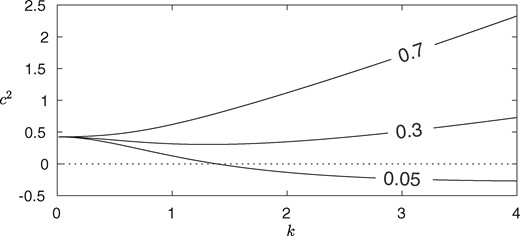
Fig. 3
Dispersion relation (3.12) with the parameter values given by equation (6.1), with varying values of (as shown in the figure). When the curve goes below (given by the dotted line), the configuration is linearly unstable.
First, let us explore the regime where the linear phase speed is monotonic. We compare a depression KdV soliton satisfying equation (4.30) with a solution to the full Euler equations with the parameter values given by equation (6.1) and . As shown in Fig. 4, the agreement is very satisfactory. Such convincing results ensure that our codes based on the numerical scheme are correctly composed. We also show in the figure a full Euler solution with the same parameter values, except . It can be seen that the solution with the electric field is less steep than the gravity-capillary solitary wave. While there is little difference in the profiles, the effect on the speed of the wave is dramatic. The solution has , while the solution has . Increasing further, one finds that the speed of the soliton approaches zero. This is shown in Fig. 5, where we have fixed and allowed to vary. A relationship between and is found. The points and on the figure correspond to the solutions shown in Fig. 4.
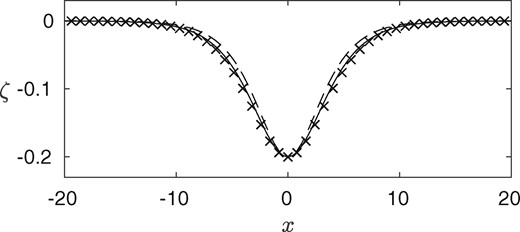
Fig. 4
Comparison of computations for a depression soliton with , , , , and by the full Euler (solid line) and by (4.30) (crosses). The dashed curve is a full Euler solution with .
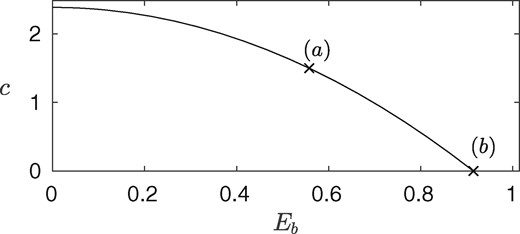
Fig. 5
A branch of depression solitons with , , and . We see that, as is increased, the speed of the wave decreases, until eventually no depression soliton solutions are found for . The points and correspond to the solid and dashed curve in Fig. 4, respectively.
Next, consider the regime, where the dispersion relation experiences a minimum . We compute solitary wavepackets in the full Euler regime. By (29), these solutions can be approximated by the associated Nonlinear Schrödinger (NLS) Equation’s solitary wave solution at small amplitude. Both elevation and depression solitary wave packets bifurcate from the minimum of the dispersion relation by (30). Without any knowledge on the NLS, an alternative approach to discover these solitary waves is to apply an artificial Gaussian pressure to the free-surface, and find solutions with which are perturbations to the uniform stream (characterised by small amplitudes). We then follow the branch of solutions with an artificial pressure to larger amplitudes. Once a suitably large solution is found, one can use this solution as an initial guess for a solitary wave packet with no artificial pressure. This trick has been used in previous literature, for example in (31). Here, we only show the existence of the wavepackets as presented in Fig. 6. The rigorous analysis of these waves requires a future study on the NLS.
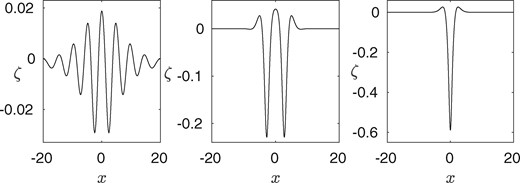
Fig. 6
Solitary wavepacket profiles. All have parameter values given by (6.1), and . The figures on the left and in the centre are elevation solitary waves, while the figure on the right is a depression solitary wave.
We seek non-resonant periodic waves with by using a linear solution as the initial guess in Newton’s method. The continuation over the amplitude is shown in the left graph of Fig. 7. The corresponding wave profiles are plotted on the right. Highly nonlinear solution possess a sharp trough and a broad crest. We follow to find resonant periodic waves with the same inverse Bond number and by choosing the value of from (3.12) such that the solution experiences second, third, fourth and fifth mode resonance respectively as presented in Fig. 8(a)–(d).
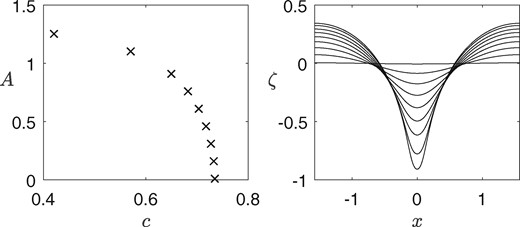
Fig. 7
Computations for periodic waves with , , , , and various values of . The figure on the left is the amplitude-speed diagram. The associated wave profiles are shown in the rightmost figure.
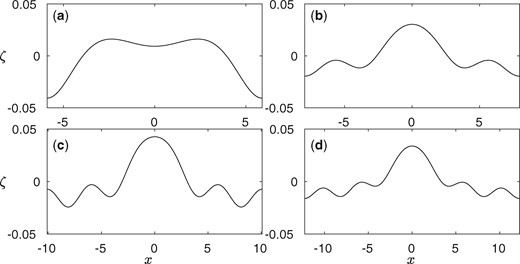
Fig. 8
Typical wave profiles of resonant periodic solutions with , , , and . The value of is chosen such that the solution experiences second, third, fourth and fifth mode resonance respectively for graphs –.
Additionally, due to the presence of a phase speed minimum, resonance of the long wave (elevation soliton as predicted by the associated KdV) with a short wave occurs at zero wavenumber resulting in non-decaying oscillatory ripples in the tail. These solutions are called generalised solitary wave, and they can be found numerically by extending the wavelength of a periodic solution with speed greater than the long wave speed. As one increases the wavelength more ripples appear in the far field. We stop the numerical procedure when there is minimal change in the profile as the wavelength is further increased. Further by a continuation on the branch, a complete diagram is obtained for as presented in Fig. 9. The wavelength chosen here is , and the corresponding phase speed from the linear dispersion relation (3.12) is about . When the amplitude is close to zero, the branch approaches the predicted phase speed marked by a circle. The associated long wave speed from (4.24) is marked by a diamond. The difference between the values stems from the fact that we have approximated generalised solitary waves with solutions of finite wavelength. The gap between the circle and the diamond is decreased as the wavelength is increased. In the limit of long wave, these two points collapse. Two typical wave profiles are plotted on the right of the figure. Despite of the almost flat surface in the tail, profile is not an embedded soliton since there are still tiny ripples of size comparable to the numerical error from Newton’s method.

Fig. 9
The figure on the left is an amplitude-speed diagram of the generalised elevation solitary waves with , , , and . The phase speed predicted by the dispersion relation is marked a circle on the axis. The long wave speed is marked as a diamond. The corresponding profiles for the waves which are marked by a cross in the left graph are shown in the right three figures.
7. Conclusion
In conclusion, we have presented linear, weakly nonlinear and fully nonlinear solutions to the generalised problem of interfacial waves between a fluid and gaseous dielectric, in the presence of a vertical electric field. The linear regime under various settings has been illustrated and summarised. Korteweg de-Vries equation has been derived for long waves. A valid numerical scheme of boundary integral equation has been introduced for fully nonlinear computations. Periodic, solitary and generalised solitary waves have been computed. The bifurcation of generalised solitary waves has been discussed in detail.
Acknowledgements
The work was initiated by a MSc dissertation for University College London by J.J.S.K. and achieved during a collaborative research visit of A.D. at University of Bath sponsored by the QJMAM fund for applied mathematics (T.G.). A.D. was also supported under grant EP/M507970/1. J.M.V.D.B. was supported by EPSRC under grant EP/N018559/1.
References
[1]
Taylor
G. I.
,
Disintegration of water droplets in an electric field
,
Proc. R. Soc. A
280
(
1964
)
383
–
397
.
[2]
Taylor
G. I.
,
The force exerted by an electric field on a long cylindrical conductor
,
Proc. R. Soc. A
291
(
1965
)
145
–
158
.
[3]
Taylor
G. I.
and
Van Dyke
M. D.
,
Electrically driven jets
,
Proc. R. Soc. A
313
(
1969
)
453
–
475
.
[4]
Jones
T. B.
,
Electrohydrodynamically enhanced heat transfer in liquids—a review
,
Adv. Heat Transfer
14
(
1979
)
107
–
148
.
[5]
Ghoshal
U.
and
Miner
A. C.
,
Cooling of high power density devices by electrically conducting fluids
.
U.S. Patent
(
2003
)
6,658,861
.
[6]
Kistler
S. F.
and
Schweizer
P. M.
,
Liquid Film Coating - Scientific Principles and their Technological Implications
(
Chapman and Hall
,
Springer, New York
1997
).
[7]
Griffing
E. M.
,
Bankoff
S. G.
,
Miksis
M. J.
and
Schluter
R. A.
,
Electrohydrodynamics of thin flowing films
,
J. Fluids Eng.
128
(
2006
)
276
–
283
.
[8]
Chen
X.
,
J. Cheng and X. Yin. Advances and applications of electrohydrodynamics
,
Chin. Sci. Bull.
48
(
2003
)
1055
–
1063
.
[9]
Papageorgiou
D. T.
,
Film flows in the presence of electric fields
,
Ann. Rev. Fluid Mech.
51
(
2019
)
155
–
187
.
[10]
Taylor
G.
and
McEwan
A.
,
The stability of a horizontal fluid interface in a vertical electric field
,
J. Fluid Mech.
22
(
1965
)
1
–
15
.
[11]
Melcher
J. R.
and
Schwarz
W. J.
,
Interfacial relaxation overstability in a tangential electric field
,
Phys. Fluids
11
(
1968
)
2604
–
2616
.
[12]
Zubarev
N. M.
and
Kochurin
E.
,
Nonlinear dynamics of the interface between fluids at the suppression of Kelvin-Helmholtz instability by a tangential electric field
,
JETP Lett.
104
(
2016
)
275
–
280
.
[13]
Barannyk
L. L.
,
Papageorgiou
D. T.
and
Petropoulos
P. G.
,
Suppression of Rayleigh-Taylor instability using electric fields
,
Math. Comp. Simul.
82
(
2012
)
1008
–
1016
.
[14]
Cimpeanu
R.
,
Papageorgiou
D. T.
and
Petropoulos
P. G.
,
On the control and suppression of the Rayleigh-Taylor instability using electric fields
,
Phys. Fluids
26
(
2014
)
022105
.
[15]
Papageorgiou
D. T.
,
J.-M. Vanden-Broeck, Large-amplitude capillary waves in electrified fluid sheets
,
J. Fluid Mech.
508
(
2004
)
71
–
88
.
[16]
Papageorgiou
D. T.
,
Petropoulos
P. G.
and
Vanden-Broeck
J.-M.
,
Gravity capillary waves in fluid layers under normal electric fields
,
Phys. Rev. E
72
(
2005
)
051601
.
[17]
Papageorgiou
D. T.
and
Vanden-Broeck
J.-M.
,
Numerical and analytical studies of non-linear gravity–capillary waves in fluid layers under normal electric fields
,
IMA J. Appl. Math.
72
(
2006
)
832
–
853
.
[18]
Easwaran
C.
,
Solitary waves on a conducting fluid layer
,
Phys. Fluids
31
(
1988
)
3442
–
3443
.
[19]
Perelman
T.
,
Fridman
A.
and
Eliashevich
M.
,
Modified Korteweg-de Vries equation in electrohydrodynamics
,
Sov. Phys. JETP
66
(
1974
)
1316
–
1323
.
[20]
Hunt
M. J.
and
Vanden-Broeck
J.-M.
,
A study of the effects of electric field on two-dimensional inviscid nonlinear free surface flows generated by moving disturbances
,
J. Eng. Math.
92
(
2015
)
1
–
13
.
[21]
Hammerton
P.
,
Existence of solitary travelling waves in interfacial electrohydrodynamics
,
Wave Motion
50
(
2013
)
676
–
686
.
[22]
Gleeson
H.
,
Hammerton
P.
,
Papageorgiou
D.
and
Vanden-Broeck
J.-M.
,
A new application of the Korteweg-de Vries Benjamin–Ono equation in interfacial electrohydrodynamics
,
Phys. Fluids
19
(
2007
)
031703
.
[23]
Hunt
M.
,
Vanden-Broeck
J.-M.
,
Papageorgiou
D. T.
and
Părău
E.
,
Benjamin–Ono Kadomtsev–Petviashvili’s models in interfacial electro-hydrodynamics
,
Eur. J. Mech.-B/Fluids
65
(
2017
)
459
–
463
.
[24]
Wang
Z.
,
Modelling nonlinear electrohydrodynamic surface waves over three-dimensional conducting fluids
,
Proc. R. Soc.
A 473
(
2017
)
20160817
.
[25]
Gao
T.
,
Milewski
P. A.
,
Papageorgiou
D. T.
and
Vanden-Broeck
J-M.
.
Dynamics of fully nonlinear capillary–gravity solitary waves under normal electric fields
,
J. Eng. Math.
108
(
2018
)
107
–
122
.
[26]
Gao
T.
,
Doak
A.
,
Vanden-Broeck
J.-M.
and
Wang
Z.
,
Capillary-gravity waves on a dielectric fluid of finite depth under normal electric field
,
Eur. J. Mech. B
77
(
2019
)
98
–
107
.
[27]
Dias
F.
,
Capillary–gravity periodic and solitary waves
,
Phys. Fluids
,
6
(
1994
)
2239
–
2241
.
[28]
Wang
Z.
,
Stability and dynamics of two-dimensional fully nonlinear gravity–capillary solitary waves in deep water
,
J. Fluid Mech.
809
,
530
–
552
.
[29]
Dias
F.
and
Iooss
G.
,
Capillary-gravity solitary waves with damped oscillations
,
Physica D
65
(
1993
)
399
–
423
.
[30]
Iooss
G.
and
Kirrmann
P.
,
Capillary-gravity waves on the free surface of an inviscid fluid of infinite depth: existence of solitary waves
,
Arch. Rat. Mech. Anal.
(
1996
)
136
,
1
–
19
.
[31]
Vanden-Broeck
J.-M.
and
Dias
F.
,
Gravity-capillary solitary waves in water of infinite depth and related free-surface flows
,
J. Fluid Mech.
240
(
1992
)
549
–
557
.
PDF











